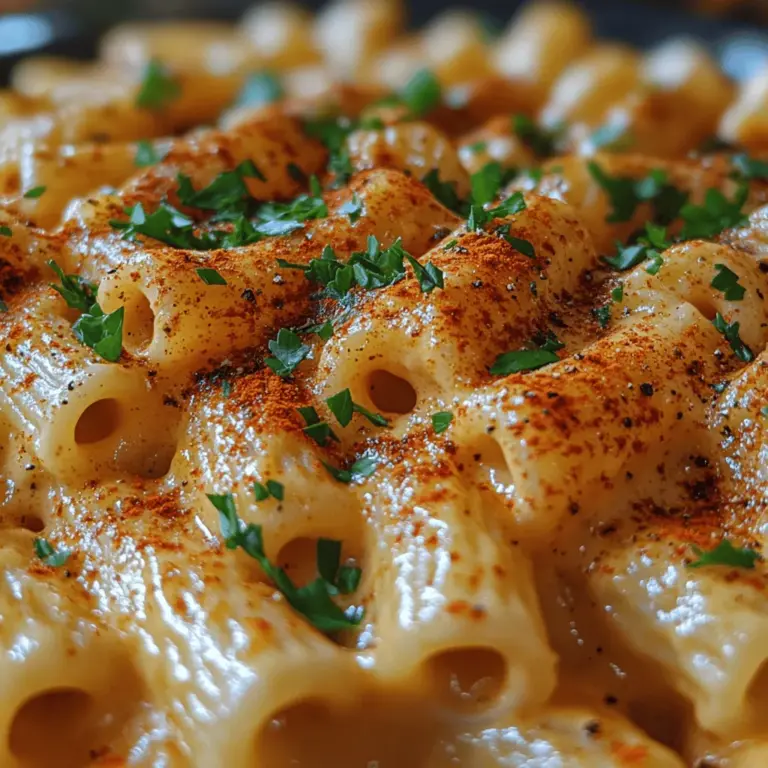Creamy Vegan Mac and Cheese Delight: A Comforting Plant-Based Twist on a Classic
In recent years, there has been a notable rise in the popularity of vegan diets. More individuals are recognizing the benefits of plant-based eating, not just for health reasons but also for environmental sustainability and ethical considerations. As a result, the culinary world has responded with an explosion of innovative vegan recipes that cater to both seasoned vegans and curious omnivores alike. One such recipe that has captured the hearts and taste buds of many is the Creamy Vegan Mac and Cheese Delight—a comforting, creamy dish that reimagines a classic favorite without any animal products.
This vegan mac and cheese recipe stands out for its rich flavor and creamy texture, which are often the hallmarks of traditional mac and cheese. However, this version is not only indulgent but also packed with nutritious ingredients that make it a guilt-free option for any meal. With the right blend of plant-based ingredients, Creamy Vegan Mac and Cheese Delight provides a delicious alternative that satisfies cravings while aligning with a healthy lifestyle. It’s an easy-to-prepare dish that can serve as a main course or a hearty side, making it a versatile addition to any meal plan.
The Appeal of Vegan Mac and Cheese
Traditional mac and cheese has long been a beloved comfort food, characterized by its creamy, cheesy sauce enveloping tender pasta. However, as more people explore veganism and plant-based diets, variations of this classic dish have emerged. Vegan mac and cheese often substitutes dairy ingredients with nuts, legumes, and plant-based milk, creating a rich and satisfying sauce without sacrificing flavor or texture.
One of the most significant advantages of a plant-based diet is its potential health benefits. Many traditional mac and cheese recipes are high in saturated fats and cholesterol, but a vegan version can be lower in these unhealthy components while still providing essential nutrients. For instance, by using whole food ingredients like cashews and nutritional yeast, you can create a dish that is not only tasty but also rich in healthy fats, proteins, and vitamins.
Moreover, vegan mac and cheese can easily accommodate various dietary preferences and restrictions. Whether you’re gluten-free, nut-free, or looking to reduce your carbohydrate intake, there are plentiful options available. Substituting traditional pasta with gluten-free alternatives or adjusting the base ingredients allows everyone to enjoy a delicious bowl of creamy goodness.
Ingredients Breakdown
To create your Creamy Vegan Mac and Cheese Delight, you will need the following primary ingredients:
1. Elbow Macaroni: The foundation of any mac and cheese dish, elbow macaroni is a classic choice that holds the creamy sauce perfectly. For those adhering to a gluten-free diet, there are plenty of alternatives available, such as chickpea or brown rice pasta. These options provide similar textures and flavors, making it easy to cater to various dietary needs. Pasta is also a good source of carbohydrates, which are essential for energy.
2. Raw Cashews: A key player in achieving the creamy texture typical of mac and cheese, raw cashews are often blended to create a rich, velvety sauce. Cashews not only add creaminess but also introduce healthy fats, proteins, and essential minerals like magnesium and copper to the dish. Their neutral flavor makes them an ideal base for a variety of sauces.
3. Unsweetened Almond Milk: This plant-based milk serves as the liquid component of the sauce. Almond milk is low in calories and often fortified with vitamins and minerals, making it a nutritious alternative to dairy milk. Other plant-based milks like oat, soy, or coconut can also be used, each bringing its unique flavor and texture to the dish.
4. Nutritional Yeast: A staple in vegan cooking, nutritional yeast adds a cheesy flavor to the dish without any dairy. It is packed with B vitamins, including B12, which is particularly important for those following a vegan diet. Nutritional yeast is a flavor powerhouse that enhances the overall taste of your mac and cheese while providing a nutritional boost.
5. Fresh Lemon Juice and Spices: The acidity from lemon juice balances the richness of the sauce, providing brightness and depth to the flavor profile. Common spices used in vegan mac and cheese recipes include garlic powder, onion powder, and paprika, which contribute additional layers of flavor while also offering health benefits.
6. Olive Oil: While optional, a drizzle of olive oil can enhance the creaminess of the sauce. Rich in monounsaturated fats and antioxidants, olive oil not only improves the texture of the dish but also adds healthy components that are beneficial for heart health.
Step-by-Step Instructions
Now that we have a solid understanding of the ingredients, let’s dive into the initial steps of preparing your Creamy Vegan Mac and Cheese Delight.
1. Cooking the Pasta: Begin by bringing a large pot of salted water to a boil. Add the elbow macaroni and cook according to the package instructions until al dente. Stir occasionally to prevent sticking. Once cooked, drain the pasta and set it aside, reserving a small cup of the pasta water for later use. This starchy water can help adjust the sauce’s consistency if needed.
2. Preparing the Creamy Sauce: While the pasta is cooking, you can start preparing the creamy cashew sauce. If you haven’t done so already, soak the raw cashews in water for at least 30 minutes to soften them. This step is crucial for achieving a smooth, creamy texture when blending. After soaking, drain and rinse the cashews, then transfer them to a blender.
3. Blending the Sauce Ingredients: To the blender with the soaked cashews, add the unsweetened almond milk, nutritional yeast, lemon juice, garlic powder, onion powder, and any other spices you wish to include. Blend on high speed until the mixture is completely smooth and creamy. If the sauce is too thick, add a bit of the reserved pasta water until you reach your desired consistency.
These initial steps will set the foundation for creating a delightful and satisfying vegan mac and cheese. Stay tuned for the next part, where we will combine the pasta with the creamy sauce and explore additional ways to elevate this dish.
{{image_2}}
Importance of Timing and Techniques for Perfect Al Dente Pasta
Cooking the perfect pasta is crucial for achieving a delectable vegan mac and cheese. The timing of your pasta cooking can make a significant difference in texture. Aim for al dente pasta, which means the pasta should be firm to the bite rather than soft and mushy. To achieve this, bring a large pot of salted water to a rolling boil before adding your pasta. The general rule of thumb is to follow the package instructions for cooking time, but start checking for doneness a couple of minutes early.
Tips for Avoiding Sticky Pasta
To prevent your pasta from becoming sticky, consider the following tips:
1. Use Plenty of Water: Ensure you have enough water in the pot; a good rule is at least 4-6 quarts for every pound of pasta.
2. Salt Your Water: Adding salt not only flavors the pasta but also helps prevent it from sticking together.
3. Stir Frequently: Stirring the pasta for the first couple of minutes will help separate the pieces and prevent clumping.
4. Do Not Rinse: After draining, avoid rinsing the pasta as this washes away the starch that helps the sauce adhere.
Preparing the Creamy Cheese Sauce
Importance of Soaking Cashews and Blending Techniques
Soaked cashews are the cornerstone of a creamy vegan cheese sauce. They provide the rich texture that mimics traditional cheese. Soak your raw cashews in water for at least 4 hours, or overnight for best results. If you’re short on time, you can soak them in hot water for about 30 minutes.
After soaking, drain and rinse the cashews. Place them in a high-speed blender along with the other sauce ingredients, which typically include nutritional yeast, garlic powder, onion powder, lemon juice, and a bit of plant-based milk. Blend until completely smooth, adjusting the amount of milk to achieve your desired consistency.
Achieving the Right Consistency and Flavor Profile
The key to a flavorful cheese sauce is to balance the ingredients. Start with the base of soaked cashews and blend until creamy. Then, add nutritional yeast for a cheesy flavor, along with garlic and onion powders for depth. A splash of lemon juice adds brightness, while a pinch of salt enhances the overall taste. If the sauce is too thick, gradually add more plant-based milk until it reaches a pourable consistency.
Heating the Cheese Sauce
Techniques for Warming Sauces Properly
Once your cheese sauce is blended to perfection, it’s time to heat it. Transfer the sauce to a saucepan over medium-low heat. Stir continuously to prevent it from sticking to the bottom of the pan and to ensure even heating.
Tips for Maintaining Creaminess Without Curdling
To keep your sauce creamy and prevent curdling, avoid high heat. Heating the sauce gently allows the flavors to meld without compromising the texture. If it begins to thicken too much, add a splash of plant-based milk to loosen it up.
Combining Pasta and Sauce
Ensuring Even Coating of Sauce on Pasta
Once your pasta is cooked to al dente perfection, drain it and return it to the pot. Pour the warm cheese sauce over the pasta and stir gently but thoroughly to ensure every piece of pasta is coated in the creamy goodness.
Tips for Serving and Presentation
For a beautiful presentation, consider the following tips:
– Serve Immediately: Vegan mac and cheese is best served hot, right after combining the sauce and pasta.
– Garnish Thoughtfully: A sprinkle of fresh herbs like parsley or chives adds color and freshness.
– Use a Nice Dish: Present your mac and cheese in a vibrant bowl or a rustic casserole dish to enhance visual appeal.
Serving Suggestions
Ideas for Garnishes: Parsley, Chives, and More
Garnishing your mac and cheese can elevate its presentation and flavor. Freshly chopped parsley or chives add a burst of color and a mild onion flavor that complements the creamy sauce. For a bit of heat, consider adding a dash of red pepper flakes or a drizzle of sriracha.
Pairing with Other Dishes: Salads, Sides, or Protein Options
Vegan mac and cheese pairs beautifully with various sides. A crisp green salad with a light vinaigrette can balance the richness of the dish. Additionally, roasted vegetables or steamed broccoli can add nutrition and color to the meal. If you’re looking for extra protein, consider serving it alongside grilled tofu or tempeh.
Creative Serving Ideas: Baked Mac and Cheese, Mac and Cheese Bowls
For those who enjoy a little extra crunch, consider baking your mac and cheese. Transfer the combined dish to a baking dish, sprinkle with breadcrumbs or crushed crackers, and bake at 350°F (175°C) for 20 minutes until golden and bubbly. Alternatively, create mac and cheese bowls by layering the pasta with sautéed vegetables, avocado slices, and a dollop of vegan sour cream for a hearty meal.
Nutritional Information
Breakdown of Calories, Fats, Proteins, and Carbohydrates Per Serving
This creamy vegan mac and cheese offers a satisfying meal option without sacrificing nutrition. A typical serving (about 1 cup) contains approximately:
– Calories: 350
– Total Fat: 12g
– Saturated Fat: 2g
– Protein: 10g
– Carbohydrates: 50g
– Fiber: 4g
Health Benefits of Each Main Ingredient
1. Cashews: Packed with healthy fats, protein, and essential minerals like magnesium and zinc, cashews contribute to heart health.
2. Nutritional Yeast: This ingredient is rich in B vitamins, especially B12, which is vital for vegans. It adds a cheesy flavor without dairy.
3. Whole Wheat Pasta: A great source of fiber, whole wheat pasta offers a more nutritious option compared to regular pasta.
Comparison with Traditional Mac and Cheese
Traditional mac and cheese can be laden with saturated fats and cholesterol due to its cheese and butter content. In contrast, this vegan version provides a similar comfort food experience while being lower in calories and free of animal products, making it a healthier choice.
Cultural Variations of Mac and Cheese
Overview of How Different Cultures Interpret Mac and Cheese
Mac and cheese is a beloved dish that varies across different cultures. In the United States, it is often associated with comfort food, while in Italy, a similar concept is found in baked pasta dishes.
Incorporating Local Flavors and Ingredients in Vegan Mac and Cheese
Consider adding local flavors to your vegan mac and cheese. For instance, incorporating spices like smoked paprika for a southern twist or using fresh herbs prevalent in Mediterranean cuisine can create unique variations.
Examples of International Vegan Mac and Cheese Recipes
Exploring international variations can inspire creativity in your cooking. For example, a Mexican-inspired version with jalapeños and a sprinkle of lime zest or an Asian twist using miso paste for depth can elevate the traditional recipe.
Common Questions About Vegan Mac and Cheese
Can I Make It Nut-Free?
If you’re looking for a nut-free alternative, consider using sunflower seeds in place of cashews. Soak them in water, then blend similarly with the other sauce ingredients. The flavor will differ slightly, but it will still yield a creamy sauce.
How to Store Leftovers and Reheat Properly?
Leftover vegan mac and cheese can be stored in an airtight container in the refrigerator for up to 4 days. To reheat, add a splash of plant-based milk to the pasta before microwaving or warming on the stovetop to maintain creaminess.
Can I Add Vegetables to the Recipe?
Absolutely! Adding vegetables like steamed broccoli, spinach, or roasted bell peppers can enhance both the nutritional value and flavor of your mac and cheese. Simply mix them in before serving or layer them in your mac and cheese bowls.
Conclusion
Creamy Vegan Mac and Cheese Delight is not only a comfort food classic but also a testament to the delicious possibilities of plant-based cooking. With its rich, creamy texture and flavorful sauce, this recipe is sure to satisfy both vegans and non-vegans alike.
Embrace the joy of cooking and give this recipe a try to experience the delightful flavors and health benefits it offers. Don’t forget to explore more vegan recipes in your culinary journey and discover the diverse world of plant-based cooking!


